Bushfoot Golf Club

Richard Engall states that "Bushfoot is a pleasure to work on", and it's easy to understand why. Situated on the ruggedly beautiful County Antrim coastline, the nine hole links course can boast 2011 Open winner Darren Clarke as a member.
Founded in 1890, the club is celebrating its 125th anniversary this year. From exceptionally humble beginnings, with just fourteen members, the fairways rented out to local farmers to graze their livestock and a 12ft x 12ft clubhouse, the 'noughties' saw the club receive a Silver Award in the HSB Top Courses of Ireland.
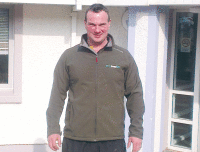
Thirty year old Richard came to the course three years ago. "I started off, quite a few years ago now, at Royal Portrush with a summertime job whilst still at school - divoting for four hours a day. When I left school, I was able to join the greens staff on a full time basis as a trainee. I worked at Portrush for ten years, but with a spell working at the Lough Erne resort for six months during the construction phase. I gained masses of knowledge and experience from working at both courses and the standards they achieved are what I aim for here today," states Richard.
"I am indebted to Joe Findlay, the recently retired Head Greenkeeper at Royal Portrush. The man has forgot more than I will ever know about greenkeeping."

Richard has one full-time member of staff and one seasonal employee. This 'team' is looking after a fifteen hectare site in which the 9-hole, par 70, 6001 yards course sits. Most holes have different tees for the back 9. For added 'interest' the course is divided by a public right of way, which includes a tram line that is in use during the summer months to transport holiday makers to and from the beach.
"The soil can best be described as heavy below the push up greens, whilst the fairways are mostly clay," continues Richard. "We are currently redeveloping the tees, having reshaped and levelled three teeing grounds this past winter. This work is ongoing and being undertaken during the off season. We are basically working our way through from what is perceived to be the worst to the better ones."
"I intend, in the near future, to upgrade the irrigation system, as most greens have only two sprinklers and the coverage is not ideal."
"We have a fairly limited budget for this work but, apart from the cost of the turf, supplied by Emerald Lawns, we can keep the cost of renovations fairly low."
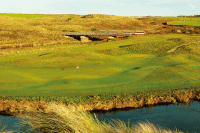
"We are recovering the greens from being areas of moss, which were described to me as being 'unsavable' by some of the members upon my appointment. I produced a five year plan to have the greens clear of moss and draining more efficiently, and we are well on the way to achieving this. The moss problem has been cured and we are encouraging more fescues and bent grasses and, with the regular verticutting - the verticutting units have been a godsend - the poa population is thinning and refining."
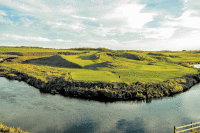
"Additionally, the green on the 5th is basically in shade all winter and can be fairly weak compared to the rest of the greens coming into spring. It is also a bit of a frost pocket and is always the last one to thaw out."
"Whilst we have to use temporary greens on occasions, we do so as little as possible."
Richard explains that they have also carried out major drainage work on the 1st fairway. "This area was basically a swamp when I arrived, so we installed a drainage network, which was dug by hand. We asked the members for their assistance and had a great turnout of volunteers who helped us immensely. Since the drains have been completed, the fairway has been playable all year round."

Tees and aprons are cut twice a week at 10mm, using a John Deere 2500B fitted with tees units; fairways are cut twice a week at 10mm using a John Deere 3235C and the rough is cut twice a week using a John Deere 8800 at 4 inches.
The greens are cut daily to a minimum of 4mm using a John Deere 2500B with QA5 (Quick Adjust) heads. Richard says that, for competitions, pedestrian cutting is performed using John Deere 220SL Precision Cut mowers and rolled using the Tru-Turf greens roller.
"They are also verticut monthly, using the Greentek Thatchaway units on the 2500B to a depth of 2mm in two directions, from as early in the season as possible until September. After the first verticut, we will sow a bent into the sward and cover with a light dressing of pure sand.
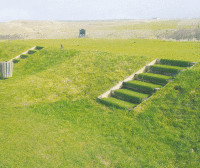
"In September, we hollow core the greens using the Groundsman aerator and overseed with fescue, then topdress to cover the seed. They are verti-drained around Christmas time using 12 inch tines."
"Fertiliser is applied as liberally as possible, Richard continues. "It is a balancing act keeping the poa in our greens happy enough that we aren't left with bare patches, but not to encourage it while we try to repopulate with more desirable species. I use three granular applications yearly to fill the belly, so to speak. I tend to use the Everris range of granulars; 16:0:16 in spring, 14:5:10 in summer and 6:0:27 coming in to September. These are topped up using Plant Marvel foliar feeds, namely the bent special range 28:8:18 in spring and summer and the 15:5:30 coming into autumn. These are applied with the addition of Ultraplex which contains micronutrients."
"Seaweed is applied monthly all year round for colour and as a micronutrients package. I use Sea Nymph double concentrate, which has given fantastic results."
"We blanket coat the fairways and semi rough with selective herbicide at the beginning and end of the growing season, using Everris React.
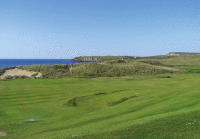
"Fortunately, we do not suffer too much where pests and diseases are concerned. The greens and fairways are sprayed with Cyren to prevent leatherjackets and a selective weedkiller is sprayed on fairways. Fusarium patch can appear at times, due to the thatch layer holding moisture during mild spells, although it is becoming less frequent the more work we do on the greens. Worms are a problem, although Caste Off tends to cure this."
Unlike other areas of the UK, golf is experiencing a resurgence in Northern Ireland, which has much to do with the recent successes of their triumvirate of tour pros; Rory McIlroy, Graeme McDowell and Darren Clarke who, as well as winning majors, have helped inspire Europe to recent Ryder Cup successes. Indeed, the 2014 Ryder Cup captain, Paul McGinley, came from the country, as will the 2016 event's captain, Darren Clarke.
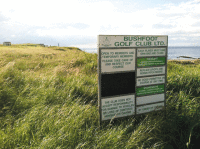
"The industry is growing and expanding into every corner of the world, which is excellent news for people such as myself who have chosen a career in greenkeeping. Yet our profile remains low. As with everything nowadays, our work needs to be highlighted through well known faces on TV producing specialised documentaries which show the public how much work goes into producing what they see during their round on a Saturday morning. It's worked for other professions, so why not ours?"
Richard concludes by saying: "Presentation is vital, I am always reminding the boys that tidiness costs nothing and, even if there is only one small area of the course looking substandard, it will be noticed."
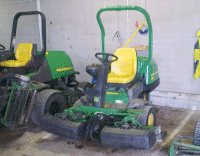
John Deere 8800 rough cut mower
John Deere 2653A Triple utility mower
John Deere 2500A Greens triple mower
John Deere 3235C fairway mower
John Deere 220SL Precision Cut pedestrian greens mowers x2
Truturf greens iron
Hardi boss sprayer
An old verti-drain which has no make/model number visible
An old slitter which, again, has no make/model number visible
Ford 2120 tractor
Groundsman 345HD pedestrian aerator
Groundsman turf/sod cutter
Flymo hover mower
Honda strimmers x 2
Cushman topdresser
Scotts/Everris spreader
GreenTek verticutting attachments
"I am allocated a budget for general purchases, like fertiliser, pesticides etc., and tend to stay within budget for the year. Any additional machinery which might be required is recommended to council by myself and the greens committee. They make the final decision.

We purchase machinery a variety of ways. The John Deere 2500b was bought brand new from Johnstone and Gilpin, whilst the JD 8800 was purchased secondhand. If a good deal comes up we are always interested. Improving our machinery is at the forefront of our minds, and should be for all course managers.
We do all servicing ourselves, with the exception of cylinder grinding which is outsourced.
We hire in a 3 tonne digger at times to help with renovation projects, and this is operated by myself and the boys.
What would my wish list include? Just to modernise our equipment to eliminate downtime, which is a regular occurence at the minute."
